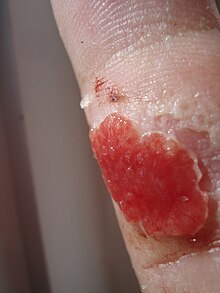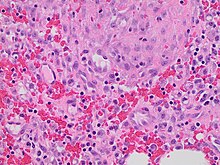6. Explain The Significance Of Granulation Tissue In The Repair Phase Of Healing?
Granulation tissue is new connective tissue and microscopic blood vessels that form on the surfaces of a wound during the healing process.[one] Granulation tissue typically grows from the base of operations of a wound and is able to make full wounds of almost any size. Examples of granulation tissue can be seen in pyogenic granulomas and pulp polyps. Its histological appearance is characterized by proliferation of fibroblasts and new thin-walled, delicate capillaries (angiogenesis), infiltrated inflammatory cells in a loose extracellular matrix.
Appearance [edit]

Example of granulation tissue from a cutting on a finger with "proud flesh".
During the migratory phase of wound healing, granulation tissue is:
- lite cherry-red or night pinkish in colour, being perfused with new capillary loops or "buds";
- soft to the bear on;
- moist;
- bumpy (granular) in appearance, due to punctate hemorrhages;
- pulsatile on palpation;
- painless when healthy;[2]
Structure [edit]
Granulation tissue is composed of tissue matrix supporting a diversity of cell types, most of which can exist associated with i of the post-obit functions:[ citation needed ]
- germination of extracellular matrix;
- operation of the immune system;
- vascularisation;
An excess of granulation tissue (caro luxurians) is informally referred to as "proud flesh".[3]
[edit]

Histopathology of granulation tissue at 11 days after injury, showing fibroblasts, haemorrhage and lymphocytes.
The extracellular matrix of granulation tissue is created and modified by fibroblasts. Initially, information technology consists of a network of type-III collagen, a weaker form of the structural protein that tin be produced rapidly. This is later replaced by the stronger, long-stranded type-I collagen, as evidenced in scar tissue.[ citation needed ]
Immunity [edit]
The primary allowed cells agile in the tissue are macrophages and neutrophils, although other leukocytes are too present. These work to phagocytize one-time or damaged tissue, and protect the healing tissue from pathogenic infection. This is necessary both to aid the healing process and to protect against invading pathogens, as the wound often does non have an effective peel barrier to act equally a outset line of defense force.[ citation needed ]
Vascularization [edit]
It is necessary for a network of blood vessels to be established as soon as possible to provide the growing tissue with nutrients, to take away cellular wastes, and transport new leukocytes to the expanse. Fibroblasts, the main cells that deposit granulation tissue, depend on oxygen to proliferate and lay down the new extracellular matrix.[ citation needed ]
In vascularisation, also called angiogenesis, endothelial cells apace grow into the tissue from older, intact blood vessels. These co-operative out in a systematic way, forming anastomoses with other vessels.[ citation needed ]

Approximate times of the different phases of wound healing,[4] with substantial variation depending on wound size and healing conditions. Granulation tissue formation is seen in dark-green box at days to weeks.
References [edit]
- ^ "Granulation Tissue Definition". Memidex . Retrieved 25 October 2022.
- ^ Bhat, Sriram (2013). Srb's Manual of Surgery, 4e. Jaypee Brother Medical Pub. p. 18. ISBN9789350259443.
- ^ Healing and Repair Archived 2010-09-27 at the Wayback Machine Chapter ix from an "Introduction to Pathology" on a Tuskegee University website
- ^ Reference list is found on epitome main page.
6. Explain The Significance Of Granulation Tissue In The Repair Phase Of Healing?,
Source: https://en.wikipedia.org/wiki/Granulation_tissue
Posted by: gunterthersemeaten.blogspot.com


0 Response to "6. Explain The Significance Of Granulation Tissue In The Repair Phase Of Healing?"
Post a Comment